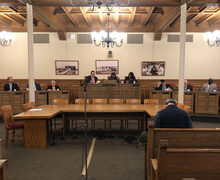Experts agree Syracuse is primed to become a climate refugee city
Illustration by Remi Jose | Illustration Editor
Because of its status as a “legacy city,” or a city with more infrastructure than is necessary for its population, experts say it’s uniquely suited to handle an influx.
To support student journalism and the content you love, become a member of The Daily Orange today.
Yvonne Chu considers Syracuse lucky.
Chu, president of the Climate Change Awareness and Action organization in Syracuse, said the city will feel the impacts of climate change like the rest of the world, but on a much milder scale. People living in places projected to be devastated by climate change will need somewhere to go.
“(People) are going to be moving from places that are devastated by climate change, weather patterns, (and) moving to places that have less severe issues when it comes to climate change,” Chu said.
In September, flooding in Pakistan displaced 32 million people. Hurricane Fiona in Puerto Rico displaced another 12,485 people in the same month. Experts said Syracuse could become a climate haven for people escaping their homes in places like Pakistan and Puerto Rico amid increasing extreme weather events and temperatures.
Other cities in New York, like Buffalo, have already dubbed themselves “climate refugee cities.” Rochester released a report in 2019 on how to work with climate refugees arriving in the city over the next few decades.
Joshua Cousins, an environmental studies professor at SUNY ESF, said people fleeing climate disasters will be a mix of climate refugees and climate migrants. While climate migrants may move in pursuit of a more desirable climate, refugees will be forced to move in the wake of a disaster, he said.
“There are going to be constrained zones of liveability, there will be people in those places that will have to move, (and) how and where they’ll move is unknown,” Cousins said.
Both Chu and Charles Driscoll, a professor of environmental systems at Syracuse University, agreed the impacts of climate change will be more mild in Syracuse than in other locations. Driscoll pointed to the city’s high latitude, availability of water and abundant land. Chu added that the city could leverage its local natural freshwater.
Updating the city’s water infrastructure to increase its capacity would be a relatively easy fix, Driscoll said.

Megan Thompson | Digital Design Director
With an increased growing season and larger volumes of precipitation in fewer rainfall events, Driscoll said the city will become warmer. Syracuse’s climate could become similar to that of North Carolina or Virginia, Driscoll said.
Chu said erratic precipitation will cause the majority of the changes.
“We’ll see more flooding, we’ll see irregular snow patterns and so on,” she said. “But, it’s very mild compared to what we’re seeing in other places.”
Cousins said Syracuse is a “legacy” city, which means it has more infrastructure than necessary for its population and can accommodate an influx of people. Other rust belt cities like Rochester and Buffalo are also legacy cities. As of 2021, Syracuse’s population is just over 146,000.
Cousins emphasized that strong social infrastructure is just as important as physical infrastructure. Syracuse has programs, such as InterFaith Works CNY’s New Americans program, designed to help people new to Syracuse and the United States, Chu said.
Syracuse already considers itself a sanctuary city, which means they don’t help federal deportations. In 2017, President Donald Trump issued an executive order to withhold federal funding for sanctuary cities. Stephanie Miner, the mayor of Syracuse at the time, said the city and its police department wouldn’t be used to enforce federal anti-immigrant policies.
“I pledge we will continue Syracuse’s commitment to our New American residents, building the trust and relationships our neighbors deserve and continue to treat them with the dignity and respect they deserve,” Miner said in a press release at the time.

Driscoll believes the city should already be preparing to become a hub for people displaced by climate change.
“It is in the city’s best interest to become a climate refugee city. I think it is a logical outcome, and I’ve been saying this for close to two decades,” Driscoll said. “I can’t imagine that this is not going to happen, and I think that central New York needs to start planning for it.”
Chu said the city should always be thinking about resiliency and sustainability.
“If they’re not thinking about it right now, it’s a big mistake,” Chu said.
While Syracuse may have the infrastructure to handle an influx of people, Driscoll said the city as a whole isn’t prepared. He said his main concerns are its overall housing, transportation and employment opportunities. He said if there is going to be a large population increase, the city needs to upgrade and increase the capacity of its wastewater plant to accommodate the influx.
Driscoll said the city should be leveraging Micron Technology – which recently announced it will invest up to $100 billion in a semiconductor manufacturing facility near Syracuse – and I-81 construction in order to be equipped as a climate haven. The investments could be a jumping-off point for the region’s development over the coming decades, he said.
“The transition needs to be done in a staged and controlled manner and the time to plan for this is now,” Driscoll said. “It honestly should have been earlier.”
Published on October 27, 2022 at 12:40 am
Contact Dana: dafries@syr.edu





